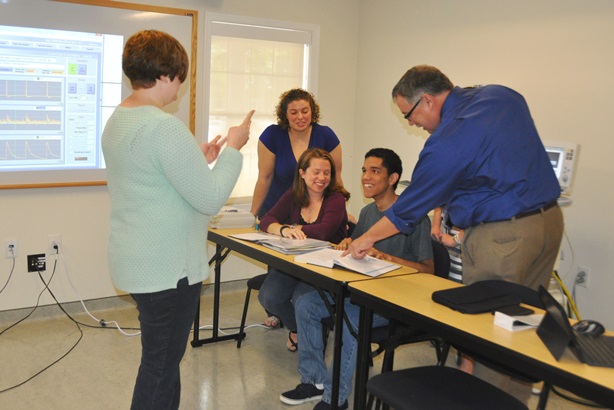SU Students Test Interdisciplinary Research Project in Simulation Center
 SALISBURY, MD---Salisbury University students Christopher Wilson and Kathy Burris recently brought their mathematics research project on mechanical ventilation to life inside the campus’ Richard A. Henson Medical Simulation Center.
SALISBURY, MD---Salisbury University students Christopher Wilson and Kathy Burris recently brought their mathematics research project on mechanical ventilation to life inside the campus’ Richard A. Henson Medical Simulation Center.
Their exploration of the math behind this breathing-assistance procedure began last spring as a group project in a course taught by Dr. Melissa Stoner of SU’s Mathematics and Computer Science Department.
Working with another student, Brooke Sproul ’14, they used differential equations to model the interaction of a mechanical ventilator with a patient’s respiratory system. The medical device is used in intensive care settings to support patients stricken with respiratory failure. The interaction is caused by the necessary management of the pressure, flow and volume between the ventilator and the respiratory system. This project is a prime example of how differential equations are used in real-life situations, the students explained.
More than a year ago, the students met with Dr. Robert Joyner, SU’s Respiratory Therapy program director, to discuss their ideas for the project. “I only provided some thoughtful questions and sources for other information and the students took it from there,” Joyner said.
Burris, a senior mathematics major, and Wilson, a junior physics major, presented their work at SU’s 2015 Student Research Conference, where Joyner saw the completed project for the first time.
“This is a terrific example of the benefits of interdisciplinary education,” said Joyner, who also is associate dean of SU’s Richard A. Henson School of Science and Technology.
He invited the students and Stoner, their faculty mentor, to demonstrate how well their mathematical model works on SU’s ASL 5000 breathing simulator, a high-fidelity test lung used to simulate and teach patient-ventilator interaction to those working with patients who are undergoing mechanical ventilation. Purchased with funds from a $1 million gift from the Richard A. Henson Foundation when the Sim Center opened, the simulator typically is used by respiratory therapy and other health care majors and practicing professionals who need to understand the treatment of respiratory failure.
“The respiratory therapy students are taught to interpret graphs that diagram patient-ventilator interaction. This allows them to understand what is occurring clinically to best manage a patient’s respiratory failure, but they don’t necessarily understand the underlying mathematics producing the graphs,” Joyner said. Similarly, Wilson and Burris grasped their equations, but had not thought about the physiological implications.
“This is a great way to make critical connections for students in both disciplines,” Joyner said. Stoner added that it takes mathematical modeling to the next level; she sees future applications for her Calculus for Biology and Medicine class.
“I think it is interesting to see how what we do in mathematics really does apply to the real world and how you can tweak different variables to benefit others,” said Burris, a graduate of the Indian River School District. After earning a B.S. from SU this spring, she will pursue a master’s at the University of Alabama at Huntsville.
“I really enjoyed the Sim Center visit,” said Wilson, who is deaf and speaks through an American Sign Language interpreter. “It provided a different viewpoint of the process of mechanical ventilation based on the fields of respiratory therapy and medicine. I gained knowledge on new terminology, variables such as types of pressure, and graphs including flow and volume that occur on screen monitors.” A 2012 Parkside High School graduate, he heads to the University of Maryland College Park to study electrical engineering this fall through SU’s engineering transfer program.
The students plan to write about their findings and cross-disciplinary experience for the American Physiological Society’s Advances Physiology in Education journal. For more information call 410-543-6030 or visit the SU website at www.salisbury.edu.
